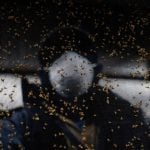You can make pastures more productive by taking grazing to a different level — literally — says Lee Sexton of Sexton Grazing and Consulting in Hanley, Sask.
Sexton told the Alberta Goat Association conference that goats and cattle don’t compete for forage, which means you can have more animals per acre. Goats stand on their hind legs and browse brush, shrubs and forbs that the cattle can’t or won’t eat.
They can also eat a high level of tannins and their diet only consists of 20 per cent grass while cattle’s diet is 70 per cent grass.
Read Also

Mosquito-borne virus could be devastating to sheep breeding operations
Cache Valley virus, a mosquito-borne disease that infects small ruminants, could be a devastating hit to small operations.
“My feeling is that anybody can feed a cow,” Sexton said. “You need some knowledge to feed small ruminants. There’s a lot more to those things than what anybody thinks.”
Goats are more selective with their lips, and can pick out individual leaves, Sexton said.
“They’re very efficient and selective at how they forage, which is why they can give the impression that they can eat anything.”
Sexton emphasized the importance of good management and record-keeping for controlling weeds on pasture. He said weeds are more likely to develop when plants are overgrazed. By the same token, intense pressure can help eliminate weeds.
“If you want to get rid of something on your land, hit it hard with a lot of numbers and hit it often. Every time that plant starts to grow and develop its leaves and you take them off, you shorten the life cycle of that plant,” Sexton said.















